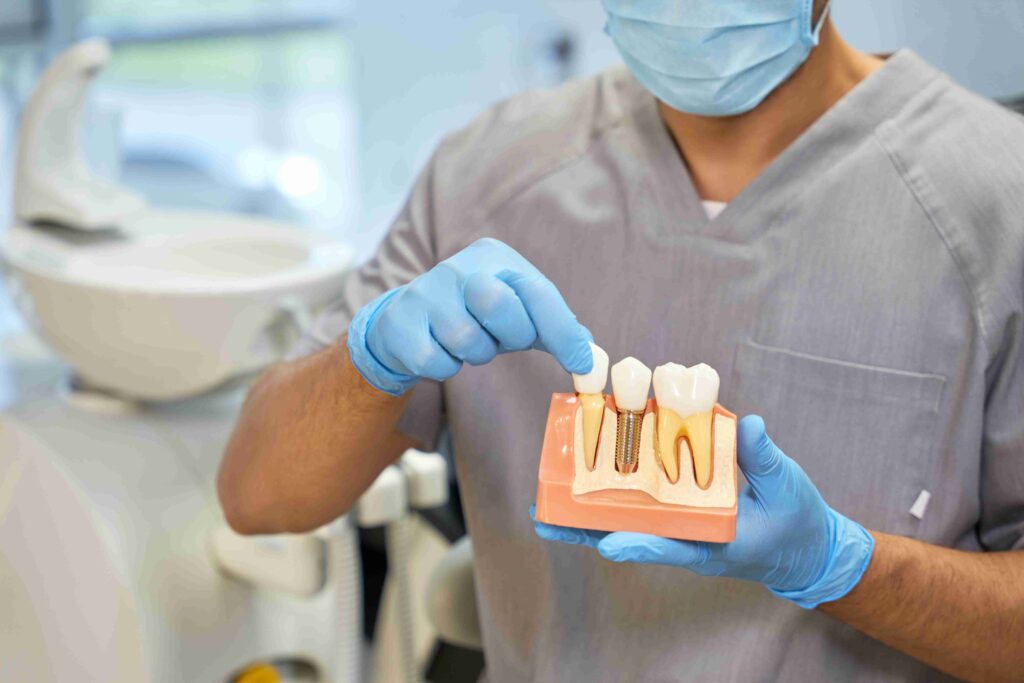A confident smile isn’t just about aesthetics; it’s a reflection of oral health. Missing teeth can impact both appearance and functionality. Fortunately, dental implants offer a solution that goes beyond traditional tooth replacement methods. In this blog post, we will delve into the world of dental implants, exploring their benefits, the procedure, aftercare, and more.
Understanding Dental Implants
What Are Dental Implants
Dental implants are sophisticated restorative options for individuals with missing teeth. They consist of three main components: the implant itself (a titanium post), the abutment (a connector piece), and the crown (the visible prosthetic tooth). What sets dental implants apart is their ability to replicate the root of a natural tooth, providing a strong foundation for the crown.
Benefits of Dental Implants
Beyond aesthetics, dental implants have transformative functional advantages. They restore the ability to chew with ease, enabling you to enjoy a varied diet without limitations. Additionally, dental implants prevent the sunken appearance that often accompanies missing teeth, contributing to a youthful and healthy facial structure. The preservation of jawbone density is a crucial long-term benefit, as implants stimulate bone growth through the process of osseointegration.
Candidacy for Dental Implants
Determining candidacy involves evaluating factors such as overall health, oral hygiene, and bone density. Even if bone loss has occurred, techniques like bone grafting can often enable individuals to become viable candidates. An in-depth consultation with a dentist or oral surgeon will help establish whether dental implants are the best solution for your unique situation.

Types of Dental Implants
Endosteal Implants
Endosteal implants are the gold standard in dental implantology. Surgically placed within the jawbone, they exhibit superior stability due to their direct connection with the bone. This type of implant is preferred when bone density is optimal and provides a secure base for single crowns or even full dentures.
Subperiosteal Implants
Subperiosteal implants offer a lifeline to individuals with insufficient jawbone height or density. They are positioned on or above the jawbone but beneath the gum tissue. Custom-designed frameworks are created to fit the contours of your jawbone, providing a stable platform for prosthetic teeth.
The Dental Implant Procedure
Initial Consultation and Planning
The journey begins with a comprehensive consultation. During this session, the dental team will assess your oral health, evaluate the condition of your jawbone, and discuss your medical history. X-rays, CT scans, and 3D models may be used to formulate a precise treatment plan tailored to your needs.
Implant Placement Surgery
Implant surgery is a meticulously performed procedure. Under local anesthesia, an incision is made in the gum tissue to expose the jawbone. A small hole is then drilled to accommodate the implant. Once the implant is in place, the gum is sutured closed. In certain cases, immediate-loading implants may be used, allowing temporary crowns to be attached on the same day.
Osseointegration and Healing
Osseointegration is a pivotal phase where the implant fuses with the jawbone. This process usually takes several months, during which the implant becomes a part of your natural anatomy. The result is a remarkably strong bond that mimics the connection between a natural tooth’s root and the jawbone.
Placing the Abutment and Crown
Once osseointegration is confirmed, an abutment is placed atop the implant. Impressions of your teeth are taken to create a customized crown that matches your existing teeth perfectly. This crown is then attached to the abutment, completing the restoration.
Aftercare and Maintenance
Post-Implant Care
During the initial days following the procedure, you may experience mild discomfort, swelling, and bruising. Over-the-counter pain relievers can help manage this discomfort. A diet of soft foods is recommended during this period to minimize strain on the healing area.
Oral Hygiene and Maintenance
Maintaining oral hygiene is paramount. Regular brushing, flossing, and rinsing with a non-alcoholic mouthwash will prevent infection and ensure the health of your implants. Regular dental check-ups allow the dentist to monitor your oral health and address any concerns promptly.
Comparing Dental Implants with Alternative Solutions
Dental Implants vs. Dentures
Dental implants surpass dentures in terms of stability, comfort, and overall function. Implants are securely anchored, eliminating concerns about slippage during speech or meals. Moreover, they prevent bone resorption, a common issue with dentures.
Dental Implants vs. Bridges
Dental implants offer a more comprehensive solution by replacing the tooth root and maintaining bone health. Bridges necessitate altering neighboring teeth for support, which can weaken them over time. Implants, on the other hand, provide a self-sufficient and durable solution.
Conclusion
Dental implants are a transformative solution for restoring missing teeth. Beyond enhancing aesthetics, they contribute to improved oral health, function, and self-esteem. By understanding the intricacies of the implant process, you can make an informed decision about this life-changing procedure. Consult with a dental professional to determine if dental implants are the right choice for you.
Table of Contents
Recent post

Dental Makeovers: Transforming Your Smile with Cosmetic Dentistry


Restoring Dental Function: Restorative Treatments for Long-Lasting Smiles
Invisalign for Adults FAQs
Is the implant procedure painful?
Local anesthesia ensures minimal discomfort during surgery. Some post-operative discomfort is expected but can be managed with prescribed pain medication.
What is the success rate of dental implants?
Dental implant success rates are high, exceeding 95%. The success is influenced by factors such as overall health, oral hygiene, and bone density.
Can implants fail?
While implant failure is rare, it can occur due to factors like infection, poor oral hygiene, smoking, or systemic health issues. Regular check-ups and proper care mitigate these risks.
